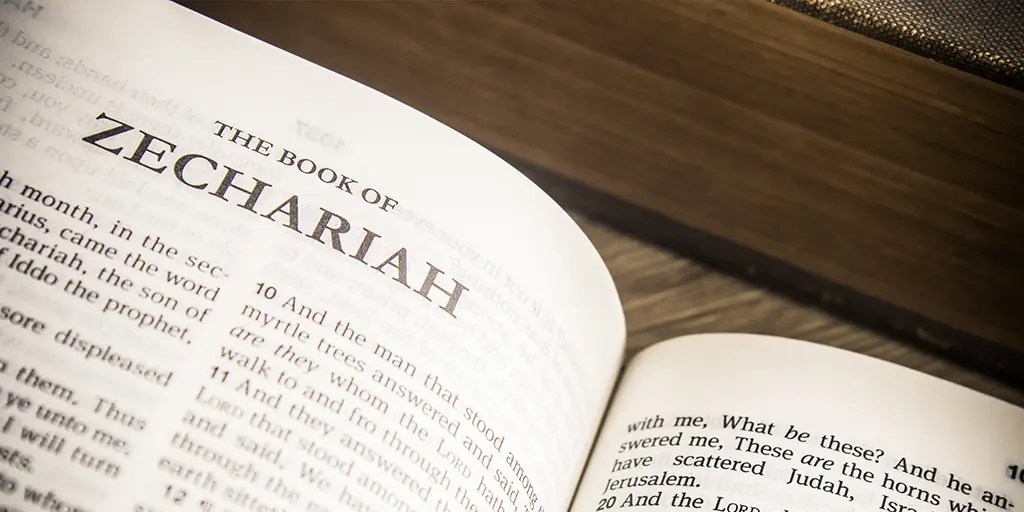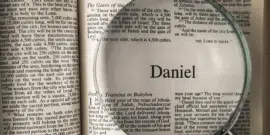Hints of the Trinity in the Old Testament (Part 2): Zechariah 2

In our ongoing exploration of Trinitarian foreshadowing in the Old Testament, we turn our attention to an intriguing prophecy in Zechariah 2. This passage offers a striking glimpse into the divine nature of the Messiah and the distinction of persons within the Godhead, providing another clear example of how the Old Testament hints at the Trinity.
Here is what we find in Zechariah 2:8-11:
“For this is what the LORD Almighty says: ‘After the Glorious One has sent me against the nations that have plundered you—for whoever touches you touches the apple of his eye—I will surely raise my hand against them so that their slaves will plunder them. Then you will know that the LORD Almighty has sent me.’
“‘Shout and be glad, Daughter Zion. For I am coming, and I will live among you,’ declares the LORD. ‘Many nations will be joined with the LORD in that day and will become my people. I will live among you and you will know that the LORD Almighty has sent me to you.’”
Let’s explore how this passage indicates the Messiah will share in God’s very essence while remaining a distinct person.
Shares in God’s Essence
The passage unambiguously presents the coming figure as the LORD Himself, sharing fully in the divine essence:
- Divine Identity of the Speaker: The passage opens with “This is what the LORD Almighty says” (v. 8), establishing that the LORD (Yahweh), God’s personal covenantal name, is the speaker throughout. This is reinforced in verse 10 with “declares the LORD.” Thus, every “I” and “me” in the passage refers to the LORD Himself.
- Divine Sender and Sent: The LORD then states, “the Glorious One has sent me” (v. 8) and twice declares, “the LORD Almighty has sent me” (v. 9, 11). This creates a remarkable scenario where the LORD is both the sender and the sent one. The one being sent is not a mere representative or even another divine being, but the LORD Almighty Himself. The passage twice emphasizes how it is the LORD Himself who is coming, “I am coming, and I will live among you” (vv. 10, 11).
- Affirmed by Divine Actions: The speaker not only identifies Himself as the LORD Almighty, but also performs actions that belong to the LORD alone, such as making nations “my people” (v. 11) and exercising judgment against Israel’s enemies (v. 9). He points out how these actions serve to affirm His identity: “Then you will know that the LORD Almighty has sent me” (vv. 9, 11).
This passage leaves no ambiguity: the one who is coming is the LORD Himself. He is not merely divine like the LORD, He is the LORD Almighty, coming to rescue and dwell among His people.
Distinct in Person
While the previous section established that the Coming One will share in God’s very essence, we now turn to examine how He is simultaneously spoken of as a distinct person.
- Sender and Sent: “The LORD Almighty says: ‘… the Glorious One has sent me … the LORD Almighty has sent me’” (vv. 8, 9, see also v. 11). This creates a fascinating scenario where the LORD is both the sender and the sent one.
- Alternating References: The text maintains this distinction by alternating between first person (“I”, “me”) and third person references to God (“the LORD”), sometimes within the same sentence (v. 11). This further displays the complex relationship within the LORD’s being.
The tension between the unity of God (one Yahweh) and the distinction of persons (Yahweh sending Yahweh) creates a theological framework that powerfully foreshadows the Trinity. It challenges simplistic notions of God’s oneness while steadfastly maintaining it, setting the stage for the fuller revelation of God’s triune nature in the New Testament.
Fulfilled in Christ
Having examined the Trinitarian hints in Zechariah’s prophecy, we now turn to the New Testament to see how these foreshadows find their fulfillment in Christ. The words and actions of Jesus, particularly as recorded in the Gospel of John, bring clarity to this prophetic foreshadowing.
Divine Dwelling: Jesus’ incarnation directly fulfills the LORD’s promise to come and dwell among His people. John begins his Gospel by establishing Jesus’ divine identity and distinct personhood within the Godhead: “In the beginning was the Word, and the Word was with God, and the Word was God” (John 1:1). This echoes the paradox in Zechariah where the LORD is both sender and sent. John then declares, “The Word became flesh and made his dwelling among us” (John 1:14), directly echoing Zechariah’s prophecy.
Sent by the Father: The Gospel of John contains over 30 references where Jesus explicitly refers to Himself as being sent by the Father, just as Zechariah 2 foretold. Key examples include:
- “The one who comes from above is above all…. The one whom God has sent speaks the words of God, for God gives the Spirit without limit” (John 3:31, 34).
- “Whoever believes in me does not believe in me only, but in the one who sent me. The one who looks at me is seeing the one who sent me” (John 12:44-45).
Unity and Distinction: Christ maintains the distinction of persons seen in Zechariah while also claiming unity with the Father. He asserts, “I and the Father are one” (John 10:30), yet also says, “The Father is greater than I” (John 14:28), reflecting the complex relationship between the Father and Son prophesied in Zechariah
Making People His Own: Jesus fulfills the divine prerogative of making people His own, a key aspect of the LORD’s promise in Zechariah’s prophecy. In John’s Gospel, Jesus repeatedly claims this divine right, echoing and embodying the very actions Zechariah attributed to the LORD. For instance, He states, “I am the good shepherd; I know my sheep and my sheep know me…. I have other sheep that are not of this sheep pen. I must bring them also. They too will listen to my voice, and there shall be one flock and one shepherd” (John 10:14, 16). This directly parallels Zechariah 2:11: “Many nations will be joined with the LORD in that day and will become my people.”
Conclusion
Zechariah 2:8-11 foreshadows the Trinity through a striking paradox: the LORD is presented as both the sender and the sent one. It emphatically declares that the coming one is the LORD (Yahweh) Himself, not merely a divine representative, while simultaneously distinguishing distinct persons within Him. It upholds strict monotheism yet reveals complexity within God’s unity, foreshadowing the relationship between the Father, Son, and Spirit.
In Christ, we witness the perfect fulfillment of Zechariah’s paradoxical prophecy—He is simultaneously fully God and sent by God, embodying the complex divine relationship foretold in Zechariah 2. Jesus’ claims to divine identity, His statements about being sent by the Father, and His actions in fulfilling divine prerogatives all align perfectly with Zechariah’s prophecy.
Far from being a New Testament innovation, the Trinity emerges as the culmination of God’s consistent self-revelation, with Zechariah’s prophecy providing a crucial link in this divine narrative. Here, we witness the seeds of trinitarian thought, demonstrating Scripture’s remarkable unity and the progressive nature of God’s self-disclosure across both testaments.








